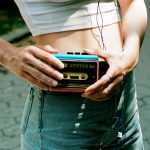To many audiophiles, there is nothing better than listening to old vinyl records with a high-end set of earphones. However, as records age through wear and use, vinyl records can sound dull and noisy. In this article, we willl take a look at a number of methods that can breathe new life into vinyl’s beloved audio format.
Cleaning
This might seem like a “duh” to many people, but the problem with vinyl records that skip or pop excessively is that they are simply dirty. And nothing sounds worse with earphones than nail-on-the-chalkboard style pop pop pop or the record jumping between grooves!
Cleaning vinyl records to restore them to their former glory is relatively easy:
First, you will want to use a carbon fiber brush to remove dust and other bits (via static electricity) that sit in the spots between the grooves of the record. With deionized or distilled water at a warm temperature, mix a small amount of dish soap. Next, dip a microfiber rag (the kind for car detailers, jewelers, glasses, etc.) into the solution, wrap the rag around your finger, and begin by lightly rubbing the vinyl in circles that follow the grooves. Make sure to go in both directions to pick up all of the stray bits that come from the pressure you are applying. Clean the record of the solution with distilled/deionized water and repeat. Then, allow the record to dry and voila, clean vinyl! For those who want a less DIY process, there are also cleaning kits that can make this process easier, especially with a large number of records.
However, the record is only the first part of cleaning. Be sure to pay attention to the paper in the center of the vinyl because old paper has a habit of breaking off and eroding into a fine dust and ruin your listening experience. Also, cleaning or replacing the vinyl’s sleeve and plastic or paper dust cover can prevent you from having to repeat this procedure too often.
There is even an in-depth tutorial that requires an “invasive” approach that many vinyl aficionados may recoil from. The guide suggests you use sandpaper to clean off the crud and worn vinyl bits. Before you automatically say no, just know this may be solution you are looking for. Just make sure to experiment on your less-prized records before taking this approach—or else!
Using Modern Needles And Equipment
Sometimes, the fault of vinyl records is not on the record itself. For audio enthusiasts, sometimes using vintage needles can make the sound duller and unable to reproduce the nuances that modern audio equipment can provide, even if you have spent an afternoon scrubbing your favorite discs. By purchasing better modern equipment, especially needles, the vinyl responds better, with the needles more pop-resistant and resistance to wear and tear. This also extends to better earphones, which can more adequately reproduce the nuances of vinyl’s direct listening experience than a cheaper pair of speakers. This surely beats the old methods of taping pennies on top of the tonearm or just dealing with the quirks that come with aging vinyl.
Ripping Vinyl Records
If you feel that you want to enjoy the quality of vinyl records without the vinyl, then digitally ripping your vinyl records is the way to go. By converting the output to FLAC and other lossless formats, you can get a near-exact audio match that many audio purists swear by.
There are a number of programs available to digitally rip your vinyl, which include Pure Vinyl and Vinyl Studio even the freeware audacity, but the process is simple: Connect the stereo output of your turntable and connect it to the stereo input of your computer. Play the vinyl after pressing “Record”, and then flip the record over when appropriate. Then, you will have a continuous file, which you can choose to splice into separate tracks or leave as-is for a vinylesque listening experience.
Repurposing
If you are willing to face modern times, remember that the popularity of vinyl records was killed by other audio formats. Tapes and 8-tracks, the formats that followed vinyl, were created with crafting a better listening experience with longer duration without having to flip the vinyl disc over or cue it to a particular track. These too were supplanted by CDs and DAT formats (among other modern variants), which leads us to today with an endless number of digital-only formats found on most playback devices that are portable (try taking your vinyl on a hike and you will see what I mean…). In other words, vinyl is a little clunky.
Therefore, if you want to make the most of your vinyl records, you may want to digitally rip the ones that are in playable condition and repurpose the rest for non-audio purposes. For instance, many people enjoy the large cover art that vinyl offers, so many affix them to their walls. The vintage look of the disc itself is a pleasurable sight to many, thus some use records (especially 45s) as drink coasters, table tops, purses, bowls, clocks, and this list goes on!
Heck, if you need some target practice, vinyl records can make an excellent alternative to clay pigeons. That is, of course, if you’ve got a friend to let them sail through the air while you blow them to pieces. Make sure to wear ear protection and earphones with a noise-cancellation effect to mitigate the loud sound of firearms!
As you can see, vinyl records are not dead if you are creative. Whether you are hoping to restore them to their original grandeur while listening with your favorite earphones or you are looking to spruce up your house with their classic appeal, there are plenty of ways to give new life to old vinyl records. All in all, it is up to your creativity!







